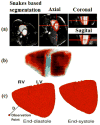Comparative analysis of three different modalities for characterization of the seismocardiogram
- PMID: 19964786
- PMCID: PMC3313588
- DOI: 10.1109/IEMBS.2009.5334444
Comparative analysis of three different modalities for characterization of the seismocardiogram
Abstract
We introduce and compare three different modalities to study seismocardiogram (SCG) and its correlation with cardiac events. We used an accelerometer attached to the subject sternum to get a reference measure. Cardiac events were then approximately identified using echocardiography. As an alternative approximation, we used consecutive Cine-MRI images of the heart to capture cardiac movements and compared them with the experimental SCG. We also employed an anatomically accurate, finite element base electromechanical model with geometry built completely from DT-MRI to simulate a portion of the cardiac cycle as observed in the SCG signal. The preliminary results demonstrate the usability of these newly proposed methods to investigate the mechanism of SCG waves and also demonstrate the usability of echocardiograph in interpretation of these results in terms of correlating them to underlying cardiac cycle events.
Figures






Similar articles
-
Comparative analysis of seismocardiogram waves with the ultra-low frequency ballistocardiogram.Annu Int Conf IEEE Eng Med Biol Soc. 2009;2009:2851-4. doi: 10.1109/IEMBS.2009.5333649. Annu Int Conf IEEE Eng Med Biol Soc. 2009. PMID: 19964275
-
Registration of dynamic multiview 2D ultrasound and late gadolinium enhanced images of the heart: Application to hypertrophic cardiomyopathy characterization.Med Image Anal. 2016 Feb;28:13-21. doi: 10.1016/j.media.2015.10.010. Epub 2015 Nov 10. Med Image Anal. 2016. PMID: 26619189
-
A trimodal system for the acquisition of synchronous echocardiography, electrocardiography, and seismocardiography data.Annu Int Conf IEEE Eng Med Biol Soc. 2011;2011:6911-4. doi: 10.1109/IEMBS.2011.6091740. Annu Int Conf IEEE Eng Med Biol Soc. 2011. PMID: 22255927 Free PMC article.
-
Automated motion estimation for 2-D cine DENSE MRI.IEEE Trans Med Imaging. 2012 Sep;31(9):1669-81. doi: 10.1109/TMI.2012.2195194. Epub 2012 May 3. IEEE Trans Med Imaging. 2012. PMID: 22575669 Free PMC article. Review.
-
Myocarditis in the pediatric population: A review.Congenit Heart Dis. 2019 Sep;14(5):868-877. doi: 10.1111/chd.12835. Epub 2019 Aug 21. Congenit Heart Dis. 2019. PMID: 31432626 Review.
Cited by
-
Mechanisms Underlying Isovolumic Contraction and Ejection Peaks in Seismocardiogram Morphology.J Med Biol Eng. 2012;32(2):103-110. doi: 10.5405/jmbe.847. J Med Biol Eng. 2012. PMID: 23105942 Free PMC article.
-
Contactless Stethoscope Enabled by Radar Technology.Bioengineering (Basel). 2023 Jan 28;10(2):169. doi: 10.3390/bioengineering10020169. Bioengineering (Basel). 2023. PMID: 36829662 Free PMC article.
-
Automatic Identification of Systolic Time Intervals in Seismocardiogram.Sci Rep. 2016 Nov 22;6:37524. doi: 10.1038/srep37524. Sci Rep. 2016. PMID: 27874050 Free PMC article.
-
Computational Modeling of Cardiovascular-Induced Chest Vibrations: A Review and Practical Guide for Seismocardiography Simulation.Int J Numer Method Biomed Eng. 2025 May;41(5):e70047. doi: 10.1002/cnm.70047. Int J Numer Method Biomed Eng. 2025. PMID: 40387564 Free PMC article. Review.
-
Seismocardiography-Based Cardiac Computed Tomography Gating Using Patient-Specific Template Identification and Detection.IEEE J Transl Eng Health Med. 2017 Jul 7;5:1900314. doi: 10.1109/JTEHM.2017.2708100. eCollection 2017. IEEE J Transl Eng Health Med. 2017. PMID: 28845370 Free PMC article.
References
-
- Salerno D, Zanetti J. Seismocardiography: A new technique for recording cardiac vibration. Concept, method and initial observation. J Cardiovasc Technol. 1990;9:111–117.
-
- Starr I, Wood EC. Twenty Years Studies with the Ballistocardiograph, the Relation Between the Amplitude of the First Record of ‘Health’ Adults and Eventual Mortality and Morbidity form Heart Disease. Circulation. 1961;23:714–732.
-
- Akhbardeh A, Junnila S, Koivuluoma M, Koivistoinen T, Turjanmaa V, Kööbi T, Värri A. Towards a Heart Disease Diagnosing System based on Force Sensitive chair’s measurement, Biorthogonal Wavelets and Neural Network classifiers. Engineering Applications on Artificial Intelligence. 2007;20(4):493–502.
-
- Jansen BH, Larson BH, Shankar K. Monitoring of the ballistocardiogram with the static charge sensitive bed. IEEE Trans on Biomedical Eng. 1991;38(8):748–751. - PubMed
-
- McKay WPS, Peter H, Gregon H, McKay B, Militzer J. Sternal acceleration ballistocardiography and arterial pressure wave analysis to determine stroke volume. Clin Invest Med. 1999;22(1):4–14. - PubMed
Publication types
MeSH terms
Grants and funding
LinkOut - more resources
Full Text Sources
Other Literature Sources
Research Materials
